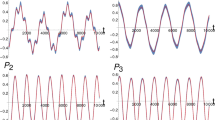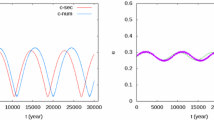Abstract
The inclinations of exoplanets detected via radial velocity method are essentially unknown. We aim to provide estimations of the ranges of mutual inclinations that are compatible with the long-term stability of the system. Focusing on the skeleton of an extrasolar system, i.e. considering only the two most massive planets, we study the Hamiltonian of the three-body problem after the reduction of the angular momentum. Such a Hamiltonian is expanded both in Poincaré canonical variables and in the small parameter \(D_2\), which represents the normalised angular momentum deficit. The value of the mutual inclination is deduced from \(D_2\) and, thanks to the use of interval arithmetic, we are able to consider open sets of initial conditions instead of single values. Looking at the convergence radius of the Kolmogorov normal form, we develop a reverse KAM approach in order to estimate the ranges of mutual inclinations that are compatible with the long-term stability in a KAM sense. Our method is successfully applied to the extrasolar systems HD 141399, HD 143761 and HD 40307.



Similar content being viewed by others
Notes
The angular momentum deficit is defined as the difference between the total value of the angular momentum and its value in the case of Keplerian circular coplanar orbits having radii equal to the semi-major axes of the planets.
Actually, when the mild hypotheses assumed in Morbidelli and Giorgilli (1995) are satisfied, the diffusion time is estimated to be super-exponentially big. This means that its order of magnitude is given by the exponential of the exponential of the inverse of a fractional power of the distance from a reference KAM torus.
Precisely, being C the total angular momentum, i.e. \(C=\sum _{k=i}^2 \varLambda _k \sqrt{1-e_k^2} \cos i_k\), the angular momentum deficit is defined as \(\hbox {AMD} =\sum _{k=i}^2 \varLambda _k (1-\sqrt{1-e_k^2} \cos i_k)\).
In the Laplace plane frame, the region of the Lidov–Kozai resonance is characterised by the libration of the argument of the pericenter of the inner planet (see Lidov 1962). The implicit adoption of such a frame has been essential in order to perform the reduction of the angular momentum sketched in Sect. 2.1. Therefore, the comparison between our results and those for that resonant region is valid because also our Hamiltonian model is written in the secular canonical coordinates with respect to the Laplace plane.
References
Arnold, V.I.: Proof of a theorem of A. N. Kolmogorov on the invariance of quasi-periodic motions under small perturbations of the Hamiltonian. Usp. Mat. Nauk 18, 13 (1963a)
Arnold, V.I.: Proof of a theorem of A. N. Kolmogorov on the invariance of quasi-periodic motions under small perturbations of the Hamiltonian. Russ. Math. Surv. 18, 9 (1963b)
Beaugé, C., Ferraz-Mello, S., Michtchenko, T.A.: Multi-planet extrasolar systems—detection and dynamics. Res. Astron. Astrophys. 12, 1044–1080 (2012)
Biasco, L., Chierchia, L., Valdinoci, E.: N-dimensional elliptic invariant tori for the planar (N \(+\) 1)-body problem. SIAM J. Math. Anal. 37(5), 1560–1588 (2006)
Butler, R.P., Wright, J.T., Marcy, G.W., Fischer, D.A., Vogt, S.S., Tinney, C.G., Jones, H.R.A., Carter, B.D., Johnson, J.A., McCarthy, C., Penny, A.J.: Catalog of nearby exoplanets. Astrophys. J. 646, 505–522 (2006)
Celletti, A.: Construction of librational invariant tori in the spin-orbit problem. J. Appl. Math. Phys. (ZAMP) 45, 61–80 (1994)
Celletti, A., Chierchia, L. (eds.): KAM Stability and Celestial Mechanics: Memoirs of the American Mathematical Society, vol. 187. American Mathematical Society, Providence, RI (2007)
Celletti, A., Giorgilli, A., Locatelli, U.: Improved estimates on the existence of invariant tori for Hamiltonian systems. Nonlinearity 13, 397–412 (2000)
Ferraz-Mello, S.: The convergence domain of the Laplacian expansion of the disturbing function. CeMDA 58, 37–52 (1994)
Gabern, F., Jorba, A., Locatelli, U.: On the construction of the Kolmogorov normal form for the Trojan asteroids. Nonlinearity 18, 1705–1734 (2005)
Giorgilli, A., Locatelli, U., Sansottera, M.: On the convergence of an algorithm constructing the normal form for lower dimensional elliptic tori in planetary systems. Celest. Mech. Dyn. Astron. 119, 397–424 (2014)
Giorgilli, A., Locatelli, U., Sansottera, M.: Secular dynamics of a planar model of the Sun-Jupiter-Saturn-Uranus system; effective stability in the light of Kolmogorov and Nekhoroshev theories. Regul. Chaotic Dyn. 22, 54–77 (2017)
Giorgilli, A., Sansottera, M.: Methods of algebraic manipulation in perturbation theory. Workshop Ser. Asociacion Argentina de Astronomia 3, 147–183 (2011)
Gröbner, W., Knapp, H.: Contributions to the Method of Lie-Series. Bibliographisches Institut, Gotha (1967)
Kolmogorov, A.N.: Preservation of conditionally periodic movements with small change in the Hamilton function. Dokl. Akad. Nauk SSSR, vol. 98, no. 527 (1954). Engl. transl. in: Los Alamos Scientific Laboratory translation LA-TR-71-67; reprinted in: Lecture Notes in Physics, vol. 93
Laskar, J.: Systèmes de variables et éléments. In: Benest, D., Froeschlé, C. (eds.) Les Méthodes modernes de la Mécanique Céleste, pp. 63–87. Editions Frontières, Dreux (1989a)
Laskar, J.: A numerical experiment on the chaotic behaviour of the solar system. Nature 338, 237–238 (1989b)
Laskar, J.: The chaotic motion of the solar system—a numerical estimate of the size of the chaotic zones. Icarus 88, 266–291 (1990)
Laskar, J.: Large scale chaos and marginal stability in the solar system. Celest. Mech. Dyn. Astron. 64, 115–162 (1996)
Laskar, J.: Large scale chaos and the spacing of the inner planets. Astron. Astrophys. 317, L75–L78 (1997)
Laskar, J.: Frequency map analysis and quasi periodic decompositions. In: Benest, D., Froeschlé, C., Lega, E. (eds.) Hamiltonian Systems and Fourier Analysis. Taylor and Francis, Cambridge (2003)
Laskar, J., Correia, A.C.M.: HD 60532, a planetary system in a 3:1 mean motion resonance. Astron. Astrophys. 496, L5–L8 (2009)
Laskar, J., Gastineau, M.: Existence of collisional trajectories of Mercury, Mars and Venus with the Earth. Nature 459, 817–819 (2009)
Laskar, J., Petit, A.C.: AMD-stability and the classification of planetary systems. Astron. Astrophys. 605, A72 (2017)
Libert, A.S., Henrard, J.: Analytical study of the proximity of exoplanetary systems to mean-motion resonances. Astron. Astrophys. 461, 759–763 (2007)
Libert, A.-S., Sansottera, M.: On the extension of the Laplace–Lagrange secular theory to order two in the masses for extrasolar systems. Celest. Mech. Dyn. Astron. 117, 149–168 (2013)
Libert, A.-S., Tsiganis, K.: Kozai resonance in extrasolar systems. Astron. Astrophys. 493, 677–686 (2009)
Lidov, M.L.: The evolution of orbits of artificial satellites of planets under the action of gravitational perturbations of external bodies. Planet. Space Sci. 9, 719–759 (1962)
Locatelli, U., Giorgilli, A.: Invariant tori in the secular motions of the three-body planetary systems. Celest. Mech. Dyn. Astron. 78, 47–74 (2000)
Locatelli, U., Giorgilli, A.: Invariant tori in the Sun-Jupiter-Saturn system. DCDS-B 7, 377–398 (2007)
Morbidelli, A., Giorgilli, A.: Superexponential stability of KAM tori. J. Stat. Phys. 78, 1607–1617 (1995)
Moser, J.: Nachrichten der Akademie der Wissenschaften in Göttingen: II. Akademie der Wissenschaften zu Göttingen Mathematisch-Physikalische Klasse. Vandenhoeck & Ruprecht, Akademie der Wissenschaften zu Göttingen Mathematisch-Physikalische Klasse (1962)
Páez, R.I., Locatelli, U.: Trojan dynamics well approximated by a new Hamiltonian normal form. MNRAS 453, 2177–2188 (2015)
Páez, R.I., Locatelli, U., Efthymiopoulos, C.: New Hamiltonian expansions adapted to the Trojan problem. Celest. Mech. Dyn. Astron. 126, 519–541 (2016)
Poincaré, H.: Leçons de Mécanique Céleste professées a la Sorbonne. Tome I, Théorie générale des perturbations planetaires, Gautier-Villars, Paris (1905)
Petit, A.C., Laskar, J., Boué, G.: AMD-stability in the presence of first-order mean motion resonances. Astron. Astrophys. 607, A35 (2017)
Robutel, P.: Stability of the planetary three-body problem—II. KAM theory and existence of quasiperiodic motions. Celest. Mech. Dyn. Astron. 62, 219–261 (1995)
Sansottera, M., Locatelli, U., Giorgilli, A.: On the stability of the secular evolution of the planar Sun-Jupiter-Saturn-Uranus system. Math. Comput. Simul. 88, 1–14 (2013)
Winn, J.N., Fabrycky, D.C.: The occurrence and architecture of exoplanetary systems. Annu. Rev. Astron. Astrophys. 53, 409–447 (2015)
Acknowledgements
M.S. has been partially supported by the National Group of Mathematical Physics (GNFM-INdAM), as part of the project “Normal Form techniques in Lattice Dynamics and Celestial Mechanics: perturbed resonant dynamics via resonant normal forms”. U.L. has been financially supported by both GNFM-INdAM and the project “DEXTEROUS - Uncovering Excellence 2014” of the University of Rome “Tor Vergata”. M.V. acknowledges financial support from the FRIA fellowship.
Author information
Authors and Affiliations
Corresponding author
Additional information
This article is part of the topical collection on Recent advances in the study of the dynamics of N-body problem.
Guest Editors: Giovanni Federico Gronchi, Ugo Locatelli, Giuseppe Pucacco and Alessandra Celletti.
Rights and permissions
About this article
Cite this article
Volpi, M., Locatelli, U. & Sansottera, M. A reverse KAM method to estimate unknown mutual inclinations in exoplanetary systems. Celest Mech Dyn Astr 130, 36 (2018). https://doi.org/10.1007/s10569-018-9829-5
Received:
Revised:
Accepted:
Published:
DOI: https://doi.org/10.1007/s10569-018-9829-5




